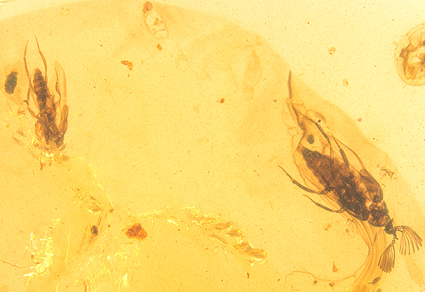Abstract
The second species of the ripidiine genus Ripidinelia Batelka & Prokop, R. daiboyui Li & Cai sp. nov., is reported from mid-Cretaceous Kachin amber of northern Myanmar. Ripidinelia daiboyui is distinguishable from R. burmiticola Batelka & Prokop by having 5-5-4 tarsi. The apically dentate pretarsal claws found in R. daiboyui are rarely present in Ripidiinae. Together with previous studies, our discovery emphasizes the palaeodiversity of Ripiphoridae during the late Mesozoic.
References
- Besuchet, C. (1956) Biologie, morphologie et systématique des Rhipidius (Col. Rhipiphoridae). Bulletin de la Société Entomologique Suisse, 29, 73–144. https://doi.org/10.5169/seals-401265
- Besuchet, C. (1957) Contribution à l’étude des Rhipidiinae (Col. Rhipiphoridae). Bulletin de la Société Vaudoise des Sciences Naturelles, 66, 341–351. https://doi.org/10.5169/seals-274731
- Batelka, J. & Prokop, J. (2023) The earliest representative of Eorhipidiini (Tenebrionoidea: Ripiphoridae: Ripidiinae) discovered in Cretaceous amber. Annales Zoologici, 73, 313–327. https://doi.org/10.3161/00034541ANZ2023.73.2.011
- Batelka, J., Engel, M.S., Falin, Z.H. & Prokop, J. (2011) Two new ripidiine species in Dominican amber with evidence of aggregative behaviour of males “frozen” in the fossil record (Coleoptera: Ripiphoridae). European Journal of Entomology, 108, 275–286. https://doi.org/10.14411/eje.2011.037
- Batelka, J., Engel, M.S. & Prokop, J. (2018) A remarkable diversity of parasitoid beetles (Ripiphoridae) in Cretaceous amber, with a summary of the Mesozoic record of Tenebrionoidea. Cretaceous Research, 90, 296–310. https://doi.org/10.1016/j.cretres.2018.04.019
- Cai, C.Y., Yin, Z.W. & Huang, D.Y. (2018) A new ripiphorid beetle from Upper Cretaceous Burmese amber sheds light on early evolution of the extant subfamily Ripidiinae (Coleoptera: Ripiphoridae). Comptes Rendus Palevol, 17, 351–356. https://doi.org/10.1016/j.crpv.2017.12.002
- Falin, Z.H. (2003) Phylogenetic analysis and revision of the genera and subfamilies of the Ripiphoridae (Coleoptera). University of Kansas, Lawrence, KS.
- Falin, Z.H. & Engel, M.S. (2010) Notes on Cretaceous Ripidiini and revised diagnoses of the Ripidiinae, Ripidiini, and Eorhipidiini (Coleoptera: Ripiphoridae). Alavesia, 3, 35–42.
- Falin, Z.H. & Engel, M.S. (2014a) Serendipity at the Smithsonian: The 107-year journey of Rhipidocyrtus muiri Falin & Engel, new genus and species (Ripidiinae, Ripidiini), from jungle beast to valid taxon. ZooKeys, 424, 101–116. https://doi.org/10.3897/zookeys.424.7853
- Falin, Z.H. & Engel, M.S. (2014b) A new genus and two new extant species closely allied with the fossil genus Pauroripidius (Coleoptera: Ripiphoridae). Journal of the Kansas Entomological Society, 87, 333–344. https://doi.org/10.2317/JKES130924.1
- Fu, Y.Z., Li, Y.D., Su, Y.T., Cai, C.Y. & Huang, D.Y. (2021) Application of confocal laser scanning microscopy to the study of amber bioinclusions. Palaeoentomology, 4 (3), 266–278. https://doi.org/10.11646/palaeoentomology.4.3.14
- Lawrence, J.F., Falin, Z.H. & Ślipinśki, A. (2010) Ripiphoridae Gemminger and Harold, 1870 (Gerstaecker, 1855). In: Leschen, R.A.B., Beutel, R.G., Lawrence, J.F. (Eds), Handbook of Zoology, Arthropoda: Insecta, Coleoptera, beetles, Vol. 2: morphology and systematics (Elateroidea, Bostrichiformia, Cucujiformia partim). Walter de Gruyter, Berlin, pp. 538–548. https://doi.org/10.1515/9783110911213.538
- Riek, E.F. (1955) The Australian rhipidiine parasites of cockroaches (Coleoptera: Rhipiphoridae). Australian Journal of Zoology, 3, 71–94. https://doi.org/10.1071/ZO9550071
- Selander, R.B. (1957) The systematic position of the genus Nephrites and the phylogenetic relationships of the higher groups of Rhipiphoridae (Coleoptera). Annals of the Entomological Society of America, 50, 88–103. https://doi.org/10.1093/aesa/50.1.88
- Vega-Badillo, V., Cancino-López, R.J., Martins, C.C. & Contreras-Ramos, A. (2022) A remarkable new genus and species of wedge-shaped beetle from Volcán Tacaná, Mexico (Coleoptera: Ripiphoridae: Ripidiinae). Biologia, 77, 479–488. https://doi.org/10.1007/s11756-021-00978-5
- Viana, J.M. (1971) Micholaeminae, nueva subfamilia de Ripiphoridae y Micholaemus gerstaeckeri, nuevo genero y especie de la Republica Argentina. Revista de la Sociedad Entomologica Argentina, 33, 69–76.


